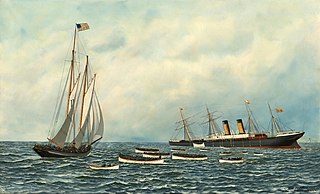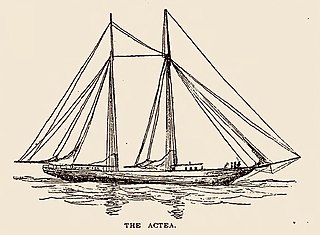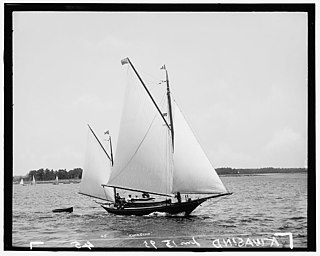
Alexander M. Lawrence was the last of the 19th-century sailing schooners to be in the New York pilot boat service as a station boat. She was one of the largest and fastest in the Sandy Hook fleet. She was built to take the place of the New York pilot-boat Abraham Leggett, No. 4, that was hit by the steamship Naples, in 1879. Her boat model won a medal at the 1893 Chicago World's Fair illustrating the perils of the pilot-boat service. In the age of steam, the Lawrence was sold by the Pilots' Association to the Pacific Mining and Trading Company in 1897.

C. & R. Poillon was a 19th century shipyard company in Brooklyn, New York. The company employed over 300 workers, owned several shipyards, and launched 175 vessels. The company was one of the best known clipper ship firms and the last of the wooden hulled boat builders in New York.

The Edward C. Knight, also known as the E. C. Knight, was a 19th-century pilot boat built by the C. & R. Poillon shipyard in 1875 for the Delaware River Pilots. She was the finest and fastest pilot-boat belonging to the Philadelphia port. She was sold to the Brunswick Pilots' Association of Georgia in 1898.

The Sylph was a 19th-century pilot boat first built in 1834, by Whitmore & Holbrook for John Perkins Cushing as a Boston yacht and pilot-boat for merchant and ship owner Robert Bennet Forbes. She won the first recorded American yacht race in 1835. She was a pilot boat in the Boston Harbor in 1836 and 1837 and sold to the New York and Sandy Hook Pilots in October 1837. She was lost in winter of 1857 with all hands during a blizzard off Barnegat, New Jersey. The second Sylph was built in 1865 from a half-model by Dennison J. Lawlor. The third Sylph was built in 1878 at North Weymouth, Massachusetts for Boston Pilots. She was sold out of service in 1901, after 23 years of Boston pilot service.

The Phantom was a 19th-century Sandy Hook pilot boat built in 1867 from the designs by Dennison J. Lawlor. The schooner was considered a model for her type with a reputation for being very fast. She helped rescue the passengers on the steamship SS Oregon when it sank in 1886. She was one of the pilot-boats that was lost in the Great Blizzard of 1888. The Phantom was replaced by the pilot-boat William H. Bateman.

The Thomas S. Negus was a 19th-century two-masted Sandy Hook pilot boat, built by C. & R. Poillon shipyard in Brooklyn in 1873 for the New Jersey maritime pilots. She was built to replace the pilot boat Jane, No. 1, which sank in early 1873. She was the winner of a $1,000 prize at the Cape May Regatta in 1873. She was named for Thomas S. Negus, president of the N. J. Pilots' Commissioners. In 1897, she left the pilot service to prospect for gold during the Klondike Gold Rush.

The Washington was a 19th-century Sandy Hook pilot boat built in 1845 by C. & R. Poillon for New York Pilots. She was rebuilt several times, the last with the sail number "22" painted on her mainsail. In 1884, she was sunk by the German steamship Roma, and then replaced by a new Washington.
The David T. Leahy was a 19th-century two-masted pilot boat schooner, built in 1890 at the C. & R. Poillon shipyard in New York City. She was named in honor of David T. Leahy, a wealthy woolen merchant. She was said to be the fastest boat in the New York and New Jersey fleet. In 1899, the David T. Leahy was renamed the James Gordon Bennett when the pilots consolidated their business. She sank off Sandy Hook when the German Atlas Line steamship Alene hit her in 1901.

The Mary A. Williams was a 19th-century Sandy Hook pilot boat, built in 1861 by the shipbuilder Edward F. Williams in Greenpoint, Brooklyn, for a group of New York pilots. She was named Mary Ann Williams after the wife of the builder. The boat was considered one of the finest connected with the pilot service. She survived the Great Blizzard of 1888. In the age of steam, the Mary A. Williams was sold in 1896.

The Centennial was a 19th-century wood pilot boat built in 1876 by Robert Crosbie and designed by Boston designer Dennison J. Lawlor for New York and New Jersey pilots. She was one of the pilot-boats that survived the Great Blizzard of 1888. By 1898, in the age of steam, she was the last pilot boat left in the fleet; then sold in 1898 to a group in Montego Bay, Jamaica.

The Edward E. Barrett, or Edward E. Bartlett, was a 19th-century two-masted Sandy Hook pilot boat, built by C. & R. Poillon in 1883 and designed by William Townsend. She helped transport New Jersey maritime pilots between inbound or outbound ships coming into the New York Harbor. She was one of the pilot boats that survived the Great Blizzard of 1888. In the age of steam, the Barrett ended her pilot commission and was sold in 1904.

The Caprice was a 19th-century Sandy Hook pilot boat built in 1871 by Brown & Lovell in East Boston, Massachusetts for Peter McEnany and other New York pilots. In 1876, she was run down and sank, off Bay Ridge, Brooklyn, by the steamship New Orleans. She was raised and was one of the pilot boats that survived the Great Blizzard of 1888. The Caprice was last reported sailing off the coast of New York in 1891.

The Actaea, or Actea, was a 19th-century Boston yacht built in 1880 by Weld and David Clark of Kennebunk, Maine for David Sears, Jr., of Montgomery Sears of Boston. She was purchased by a group of New York Sandy Hook Pilots in 1890. She was one of the largest and fastest pilot boats in the fleet. In the age of steam, the Actaea was sold in 1896 to John J. Phelps of the New York Yacht Club and used as a pleasure yacht.

The Mary E. Fish was a 19th-century Sandy Hook pilot boat, built at the Edward F. Williams shipyard of Greenpoint, Brooklyn in 1861 for Richard Brown and the New York Pilots. She was built to replace the Mary Taylor. The Fish was hit and sank by the schooner Frank Harrington in 1885 and replaced by the David Carll.

Charlotte Webb was a 19th-century New York City pilot boat built in 1865 at the Webb & Bell shipyard to take the place of the James Funk, that was destroyed by the rebel Tallahassee during the Civil War. She survived the Great Blizzard of 1888, but was run down by the French steamship La Normandie in 1889. She was replaced by the pilot boat George H. Warren.
The A. T. Stewart was a 19th-century Sandy Hook pilot boat built in 1865 at the Edward F. Williams shipyard to replace the pilot boat George Steers, which was lost in 1865. She was built for the New Jersey and New York Sandy Hook Pilots Association. The Stewart was in a collision with the steamship Scotia and sank in 1869. She was replaced by the James Gordon Bennett in 1870.
The Mary and Catherine was a 19th-century New York pilot boat built in 1848 by the Jacob Aaron Westervelt shipyard. She was hit and sunk by the steamship Haverton in 1885. The collision was the subject of a court case that went to the Supreme Court of the United States as Devere v. The Haverton. The Mary and Catherine was replaced by the pilot boat William H. Starbuck.

The William H. Bateman, a.k.a. Commodore Bateman, was a 19th-century Sandy Hook pilot boat built in 1888 at the C. & R. Poillon shipyard in south Brooklyn. She was replaced the pilot-boat Phantom that was lost in the Great Blizzard of 1888. She was run down and sank by the Hamburg steamship Suevia in 1889.

Elbridge T. Gerry was a 19th-century New York Sandy Hook pilot boat built in 1888 at the Robinson & Waterhouse shipyard in City Island, Bronx. She was named in honor of Elbridge Thomas Gerry, a commodore of the New York Yacht Club. She served as a pilot boat from 1888 to 1896, when she was sold for offshore yachting cruises. Her name was changed to Kwasind, after the strongman in Henry Wadsworth Longfellow's Song of Hiawatha.

The J. Henry Edmunds was a 19th-century pilot schooner built in 1887 in Brooklyn, New York for Philadelphia pilots. She sank in 1892 and a second Edmunds was built in 1893, which lasted thirty-five years before she sank in bad weather outside Cape Henlopen in 1928. She was the last schooner-rigged pilot boat in the Delaware Bay.
















